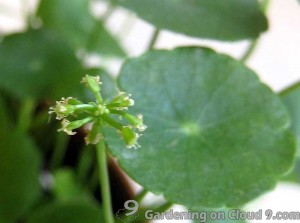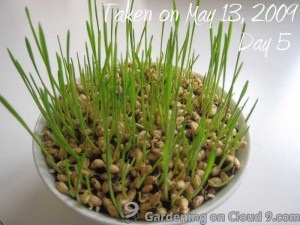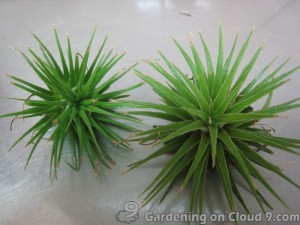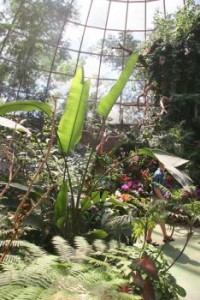|
|
By Sandy, on June 7th, 2009
 When I found my Chinese Money Plant, Pilea peperomioides, blooming with some tiny white inflorescences last month, I knew that I was wrong when I told Louise that Chinese Money Plants never blossom … When I found my Chinese Money Plant, Pilea peperomioides, blooming with some tiny white inflorescences last month, I knew that I was wrong when I told Louise that Chinese Money Plants never blossom …
Besides Louise, I have a few other friends who guessed the plant that I used in my tabletop garden – Money Bowl is Nasturtium. Actually, it could be quite confusing since both plants have leaf stalks growing from the center of the leaf disks. Yet, it will be very easy to separate the two plants when they blossom.
Continue reading Chinese Money Plant & Nasturtium
By Sandy, on May 31st, 2009
 Because of the mold that I have found on my wheatgrass, I have done some research on this subject, and have learned that mold is actually quite a common problem when growing wheatgrass. And while mold doesn’t look very appetizing, it isn’t harmful to our health. As long as we cut the wheatgrass way above the mold that is grown on the soil, and rinse the grass, it is safe to juice them or give them to our pets as snacks (a large number of young grass species, including wheatgrass, can be fed to pet, check Cat Grass or Wheatgrass? for more details). Because of the mold that I have found on my wheatgrass, I have done some research on this subject, and have learned that mold is actually quite a common problem when growing wheatgrass. And while mold doesn’t look very appetizing, it isn’t harmful to our health. As long as we cut the wheatgrass way above the mold that is grown on the soil, and rinse the grass, it is safe to juice them or give them to our pets as snacks (a large number of young grass species, including wheatgrass, can be fed to pet, check Cat Grass or Wheatgrass? for more details).
Continue reading How to Prevent Mold When Growing Grasses in Containers
By Sandy, on April 18th, 2009
While we are familiar with the common names of our houseplants, most of us do not know the botanical name of our plants. This is totally fine, for it is absolutely not necessary to memorize those long, daunting botanical names. We can just use the botanical names for reference when looking up information of our plants in guidebooks or websites. Here are the reasons why we use botanical names for plant identification.
Botanical Name of a Plant – The Breakdown
The botanical name of a plant is composed of two major parts, the genus and the species of the plant. For simplicity’s sake, genus is the family and species is a member of the family.
Continue reading Botanical Name – What is in the name?
By Sandy, on April 18th, 2009
While common name is so much easier for us to use, there are several good reasons for us to use botanical names for plant identification.
Botanical Name – Unique to Only One Plant
Every plant has at least one unique botanical name (or scientific name or Latin name) to it. This means that every botanical name refers to one and only one plant. Some plants may have more than one botanical name, yet this is not very common. To avoid confusion, it is better to use botanical name for plant identification.
Continue reading Why Do We Use Botanical Names?
By Sandy, on March 31st, 2009
 With its epiphytic characteristics, Tillandsia has earned its nickname, air plant. Instead of the roots, the plants absorb water directly through their leaves, and use their roots as wire-like anchors, hanging on trees and rocks without soil. With its epiphytic characteristics, Tillandsia has earned its nickname, air plant. Instead of the roots, the plants absorb water directly through their leaves, and use their roots as wire-like anchors, hanging on trees and rocks without soil.
Underwatering and Overwatering Your Tillandsia
Probably due to Tillandsia’s common name – Air Plant, many of us tend to think that these plants need very little or no water, as living on air. Well… of course, this is not true. Just like all other plants, Tillandsias need water. Continue reading Watering Tillandsia (a.k.a. Air Plant)
By Sandy, on March 29th, 2009
 Here is a list of the most common houseplants that are suitable for indoor gardening. The houseplants in this list are mostly easy-to-grow, low maintenance, hardy plants that fit the busy lifestyle of us, the city gardeners. Here is a list of the most common houseplants that are suitable for indoor gardening. The houseplants in this list are mostly easy-to-grow, low maintenance, hardy plants that fit the busy lifestyle of us, the city gardeners.
Continue reading Suitable Plants for Indoor Gardening
|
|
 When I found my Chinese Money Plant, Pilea peperomioides, blooming with some tiny white inflorescences last month, I knew that I was wrong when I told Louise that Chinese Money Plants never blossom …
When I found my Chinese Money Plant, Pilea peperomioides, blooming with some tiny white inflorescences last month, I knew that I was wrong when I told Louise that Chinese Money Plants never blossom …

 Here is a list of the most common houseplants that are suitable for indoor gardening. The houseplants in this list are mostly easy-to-grow, low maintenance, hardy plants that fit the busy lifestyle of us, the city gardeners.
Here is a list of the most common houseplants that are suitable for indoor gardening. The houseplants in this list are mostly easy-to-grow, low maintenance, hardy plants that fit the busy lifestyle of us, the city gardeners.


Recent Comments